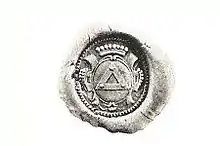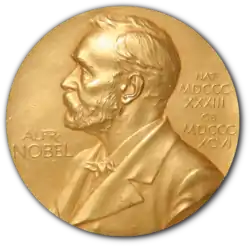Nobel family
The Nobel family (/noʊˈbɛl/ noh-BEL, Swedish: [nʊˈbɛlː]) is a prominent Swedish and Russian family closely related to the history both of Sweden and of Russia in the 19th and 20th centuries. Its legacy includes its outstanding contributions to philanthropy and to the development of the armament industry and of the oil industry. Some of its foremost members are Immanuel Nobel, the younger, engineer developer of underwater naval mines and inventor of the rotary lathe used to produce plywood, Ludvig Nobel, the founder of Branobel and one of the richest and most important men in Russia at his time, and Alfred Nobel, the inventor of dynamite who left the major part of his estate to the creation of the Nobel Prizes.

 |
Origins
The Nobel family originated from the village of Östra Nöbbelöv in Scania, hence the name. The first member was Petrus Olai Nobelius (1655–1707) who married Wendela Rudbeck (1668–1710), daughter of the famous Swedish scientist Olaus Rudbeck the Elder, also known as Olof Rudbeck.[1]
Achievements
Members of the Nobel family are known not only for their interest in art but also for their inventive ability, which is sometimes referred to as a Rudbeckian trait, inherited from their ancestor Olaus Rudbeck, the elder.[2] Immanuel Nobel pioneered the development of underwater mines, designed some of the first steam engines to power Russian ships, installed the first central heating systems in Russian homes and was the first to develop modern plywood (cut with a rotary lathe). One of his sons, Ludvig Nobel, was the founder of The Machine-Building Factory Ludvig Nobel, a great armaments concern and the inventor of the Nobel wheel. Ludvig was also the founder of Branobel, the foremost Russian oil industry of its time, and launched the world's first diesel-driven tugs and tankers, besides building the first European pipeline.[3] Alfred Nobel, who died childless, was the inventor of dynamite and the founder of the Nobel Prizes, to the creation of which he left the bulk of his estate.
The Nobel family have created several societies, including the Nobel Family Society, a private society of which only the descendants of Immanuel Nobel, the younger, are eligible as members, the Nobel Foundation, a private society administering the prizes of Alfred Nobel, and the Nobel Charitable Trust. Notably, the Director of the Nobel Foundation, Michael Sohlman, and the elected head of the Nobel family disapproves of the institution of the Nobel Charitable Trust (NCT)[4]
The Nobel family is also represented in the Nobel Prizes Award Ceremony, held in Stockholm every year. In 2007, the Nobel family archives kept in the Archives of Lund were inscribed in UNESCO's Memory of the World Register.[5]
Members
- Olof Nobelius (1706–1760), artist, (m.1750) Ana Christina Wallin (1718–1787)
- Immanuel Nobel, the Elder (1757–1839), physician, (m.1st.) Anna Kristina Rosell (1760–1795), (m.2nd.) Brita Catharina Ahlberg(1770–1823)
- Immanuel Nobel, the Younger (1801–1872), (m.1827[6][7]) Andriette Ahlsell (1803–1889)[8]
- Immanuel Nobel, the Elder (1757–1839), physician, (m.1st.) Anna Kristina Rosell (1760–1795), (m.2nd.) Brita Catharina Ahlberg(1770–1823)
Descendants of Immanuel, the younger, and Andriette Nobel
- Robert Nobel, (1829–1896), pioneer of the Russian oil industry (m.1860) Pauline Lenngrén (1840–1918)
- Ludvig Nobel, (1831–1888), founder of Branobel and its first president, (m.1st.1858) Mina Ahlsell (1832–1869), (m. 2nd. 1871) Edla Constantia Collin Nobel (1848–1921)
- Alfred Nobel, (1833–1896), the inventor of dynamite, instituted the Nobel Prizes
- Emil Oskar Nobel, (1843–1864)
Descendants of Robert and Pauline Nobel
- Hjalmar Immanuel Nobel (1863–1956), (m.1923) Countess Anna Sofia Posse (1895–1975)
- Countess Ingeborg Sofia (1865–1939), (m.1894) Count Carl von Frischen Ridderstolpe (1864–1905)
- Ludvig Emanuel Nobel (1868–1946), (m.1895) Valborg Wettergrund (1869–1940)
- Tyra Elisabeth Nobel (1873–1897)
Descendants of Ludvig and Mina Nobel
- Emanuel Nobel, (1859–1932), Branobel's second president
- Carl Nobel, (1862–1893), (m.) Mary Landzert (1865–1928)
- Andriette Nobel-Tydén (1890–1976), (m.1912) Eberhard Tydén (1885–1968)
- Birgit Maria Andriette Tydén (1913–2002)
- Carl Eberhard Tydén (1916–2012)
- Karl Göran Eugene Tydén (1918–1996)
- Mimmi Nobel-Högman (1891–1938), (m.1st.1914) Gustav Högman (1888–1947)
- Ulla Mary Elisabeth (b. 1916), (m.1939) Baron Sigvard Gustaf Beck-Friis (b. 1913)
- Baroness Christina Mary Cecilia (b. 1943), (m.1968, divorced 1981) Jean-Claude Andre (b. 1945)
- Alexandra Andre (b. 1970)
- Baron Joachim Beck-Friis (b. 1946)
- Baroness Elisabeth Ulla Alice (b. 1950), (m.1986) Baron Erik Ottoson Thott (b. 1954)
- Baroness Christina Mary Cecilia (b. 1943), (m.1968, divorced 1981) Jean-Claude Andre (b. 1945)
- Karl Gösta Bertie Högman (1918–1994), (m.1953) Chris Lundquist (1930–2011)
- Karl Gösta Jack Högman (b. 1954), (m.1984) Susanne Rosén (b. 1957)
- Mimmi Birgitta Ellinor Högman (b. 1991)
- Anna Mary Gill Högman-Granath (b. 1962), (m.1990) Ingemar Granath
- Karl Gösta Jack Högman (b. 1954), (m.1984) Susanne Rosén (b. 1957)
- Tom Åke Emanuel Högman (1922–1991)
- Ulla Mary Elisabeth (b. 1916), (m.1939) Baron Sigvard Gustaf Beck-Friis (b. 1913)
- Andriette Nobel-Tydén (1890–1976), (m.1912) Eberhard Tydén (1885–1968)
- Anna Nobel Sjögren (1866–1935)
Descendants of Ludvig and Edla Nobel
- Esther Wilhelmina (Mina) Olsen-Nobel, (1873–1929)
- Alf Igor Nobel, (1898–1968), (m. 1921) Esther Mathilda Johnsen (1898–1978)
- Hans Emanuel Nobel (b. 1922)
- Edla (Lisle) Nordenfelt (b. 1923)
- Claes Nobel, (b. 1930)
- Edla Nobel Claret de Fleurieu (1899–1996) (m.1st. 1920) Roger Daudy (1889–1933) (m.2nd. 1934) Count Médéric Claret de Fleurieu (1893–1968)
- Countess Irline Aglaé Marie Nadine (b. 1935), (m.1956) Count Henri Lombard de Buffières de Rambuteau (1925–1991)
- Jean-Marie de Buffières de Rambuteau (b. 1957)
- Marie Edla de Buffières de Rambuteau (b. 1958)
- Claude de Buffières de Rambuteau (b. 1959) (m.1991) Diane Claret de Fleurieu (b. 1961)
- Astrid de Buffières de Rambuteau (b. 1991)
- Mathilde de Buffières de Rambuteau (b. 1993)
- Cécile de Buffières de Rambuteau (b. 1995)
- Philibert de Buffières de Rambuteau (b. 1966)
- Charles de Buffières de Rambuteau (b. 1968)
- Count Patrick Camille Alfred Claret de Fleurieu (b. 1938), (m.1967) Anne Viguier (b. 1941)
- Sylvie Claret de Fleurieu (b. 1968)
- Médéric Claret de Fleurieu (b. 1969)
- Sabine Claret de Fleurieu (b. 1971)
- Countess Irline Aglaé Marie Nadine (b. 1935), (m.1956) Count Henri Lombard de Buffières de Rambuteau (1925–1991)
- Leif Jurij Nobel (1901–1938) (m.1930) Anna Elisabeth Mellén (1905–2003)
- Peter Nobel, (b. 1931)
- Eva Nobel, (b. 1935)
- Alf Igor Nobel, (1898–1968), (m. 1921) Esther Mathilda Johnsen (1898–1978)
- Ludvig Alfred (Lullu) Nobel, (1874–1935) (m.1901) Mary (Minnie) Johnson (1876–1953)
- Mary Lorna Nobel (1902–1911)
- Manuel Ludvig Nobel (1904–1911)
- Emanuel Percy Ludvig Alexis Nobel (1913–1987)
- Philip Nobel (b. 1970) (m.2007) Chantal Nobel née Cordilhac (b. 1962)
- Chloé Nobel (b. 2001)
- Philip Nobel (b. 1970) (m.2007) Chantal Nobel née Cordilhac (b. 1962)
- Ingrid Hildegard Nobel-Ahlqvist, (1879–1929)
- Marta Helena Nobel-Oleinikoff, (1881–1973), (m. 1905) Georgij Pavlovitj Oleinikoff (1864–1937)
- Nils Nobel-Oleinikoff (1905–1990), last President of Branobel (m.1st 1933) Herta Frieda ter Meer (1911–1939), (m.2nd. 1943), Dora Ahlqvist (1906–1985)
- Peter Nobel-Oleinikoff (b. 1937), (m. 1998) Anna von Holstein (b. 1943)
- Nils Nobel-Oleinikoff (b. 1944), (m. 1968) Monique de Lamare-Singery, (1947–1995)
- Christianne Oleinikoff (b. 1970) m.(2006) Bruno Ferraz-Coutinho (b. 1972)
- Sven Nobel(-Oleinikoff)
- Michael Nobel(-Oleinikoff)
- Nils Nobel-Oleinikoff (1905–1990), last President of Branobel (m.1st 1933) Herta Frieda ter Meer (1911–1939), (m.2nd. 1943), Dora Ahlqvist (1906–1985)
- Rolf Nobel, (1882–1947)
- Emil Waldemar Ludvig Nobel, (1885–1951)
- Gustaf Oscar Ludvig (Gösta) Nobel, (1886–1951)
See also
| Wikimedia Commons has media related to Nobel family. |
References
- Tolf, Robert (1976): The Russian Rockefellers : the saga of the Nobel family and the Russian oil industry Hoover Institution Press, Stanford University, p. 1. ISBN 0-8179-6581-5
- Schück, Henrik, Ragnar Sohlman, Anders Österling, Carl Gustaf Bernhard, the Nobel Foundation, and Wilhelm Odelberg, eds. Nobel: The Man and His Prizes. 1950. 3rd ed. Coordinating Ed., Wilhelm Odelberg. New York: American Elsevier Publishing Company, Inc., 1972, p. 14. ISBN 0-444-00117-4 (10). ISBN 978-0-444-00117-7 (13). (Originally published in Swedish as Nobelprisen 50 år: forskare, diktare, fredskämpar.)
- Yergin, Daniel (2003): The Prize: the Epic Quest for Oil, Money and Power, Free Press, p. 58. ISBN 0-671-79932-0
- Feder, Barnaby J. (18 October 2007). "The Nobel Prize That Wasn't". The New York Times. Retrieved 18 October 2007.
- https://web.archive.org/web/20070420041643/http://portal.unesco.org/ci/fr/ev.php-URL_ID%3D22313%26URL_DO%3DDO_TOPIC%26URL_SECTION%3D201.html
- Nilzén, Göran (2004). "Immanuel Nobel - mångsysslaren med ett växlingsrikt liv". Personhistorisk tidskrift (in Swedish). 100 (2): 157–162. Retrieved 21 October 2019.
- Fant, Kenne (1993). Alfred Nobel: A Bibliography. Translated by Ruuth, Marianne. New York: Arcade Publishing, Inc. p. 14.
- Åsbrink, Brita (2001): Ludvig Nobel: "Petroleum har en lysande framtid!" Wahlström & Widstrand, p. 19. ISBN 978-91-46-18181-1